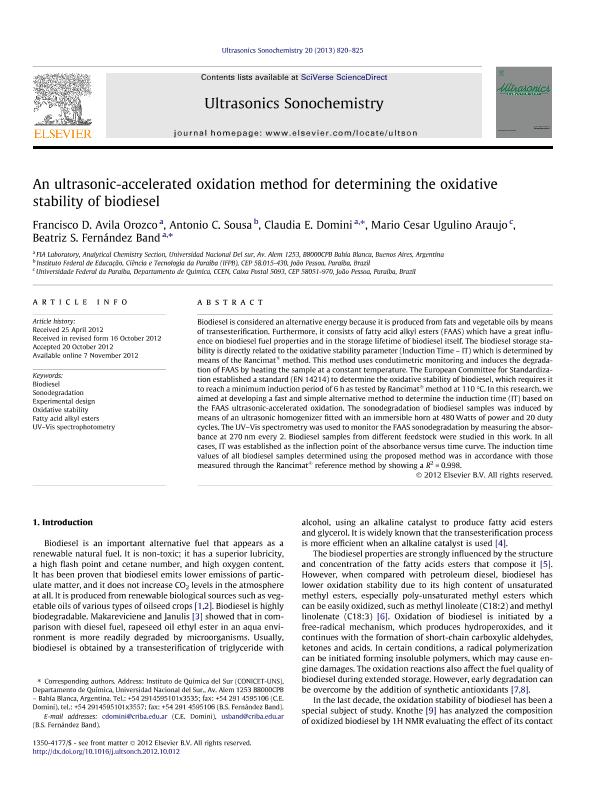Mostrar el registro sencillo del ítem
dc.contributor.author
Avila Orozco, Francisco David

dc.contributor.author
Sousa, Antonio C.
dc.contributor.author
Domini, Claudia Elizabeth

dc.contributor.author
Araújo, Mário César U.
dc.contributor.author
Fernández Band, Beatriz Susana

dc.date.available
2017-10-09T18:23:48Z
dc.date.issued
2012-11
dc.identifier.citation
Avila Orozco, Francisco David; Sousa, Antonio C.; Domini, Claudia Elizabeth; Araújo, Mário César U.; Fernández Band, Beatriz Susana; An ultrasonic-accelerated oxidation method for determining the oxidative stability of biodiesel; Elsevier; Ultrasonics Sonochemistry; 20; 3; 11-2012; 820-825
dc.identifier.issn
1350-4177
dc.identifier.uri
http://hdl.handle.net/11336/26232
dc.description.abstract
Biodiesel is considered an alternative energy because it is produced from fats and vegetable oils by means of transesterification. Furthermore, it consists of fatty acid alkyl esters (FAAS) which have a great influence on biodiesel fuel properties and in the storage lifetime of biodiesel itself. The biodiesel storage stability is directly related to the oxidative stability parameter (Induction Time – IT) which is determined by means of the Rancimat® method. This method uses condutimetric monitoring and induces the degradation of FAAS by heating the sample at a constant temperature. The European Committee for Standardization established a standard (EN 14214) to determine the oxidative stability of biodiesel, which requires it to reach a minimum induction period of 6 h as tested by Rancimat® method at 110 °C. In this research, we aimed at developing a fast and simple alternative method to determine the induction time (IT) based on the FAAS ultrasonic-accelerated oxidation. The sonodegradation of biodiesel samples was induced by means of an ultrasonic homogenizer fitted with an immersible horn at 480 Watts of power and 20 duty cycles. The UV–Vis spectrometry was used to monitor the FAAS sonodegradation by measuring the absorbance at 270 nm every 2. Biodiesel samples from different feedstock were studied in this work. In all cases, IT was established as the inflection point of the absorbance versus time curve. The induction time values of all biodiesel samples determined using the proposed method was in accordance with those measured through the Rancimat® reference method by showing a R2 = 0.998.
dc.format
application/pdf
dc.language.iso
eng
dc.publisher
Elsevier

dc.rights
info:eu-repo/semantics/openAccess
dc.rights.uri
https://creativecommons.org/licenses/by-nc-nd/2.5/ar/
dc.subject
Biodiesel
dc.subject
Sondegradation
dc.subject
Experimental Design
dc.subject
Oxidative Stability
dc.subject
Fatty Acid Alkyl Esters
dc.subject
Uv-Vis Spectrophotometry
dc.subject.classification
Otras Ciencias Químicas

dc.subject.classification
Ciencias Químicas

dc.subject.classification
CIENCIAS NATURALES Y EXACTAS

dc.title
An ultrasonic-accelerated oxidation method for determining the oxidative stability of biodiesel
dc.type
info:eu-repo/semantics/article
dc.type
info:ar-repo/semantics/artículo
dc.type
info:eu-repo/semantics/publishedVersion
dc.date.updated
2017-10-06T18:57:31Z
dc.journal.volume
20
dc.journal.number
3
dc.journal.pagination
820-825
dc.journal.pais
Países Bajos

dc.journal.ciudad
Amsterdam
dc.description.fil
Fil: Avila Orozco, Francisco David. Universidad Nacional del Sur; Argentina. Consejo Nacional de Investigaciones Científicas y Técnicas; Argentina
dc.description.fil
Fil: Sousa, Antonio C.. Instituto Federal de Educação, Ciência e Tecnologia da Paraíba; Brasil
dc.description.fil
Fil: Domini, Claudia Elizabeth. Universidad Nacional del Sur; Argentina. Consejo Nacional de Investigaciones Científicas y Técnicas; Argentina
dc.description.fil
Fil: Araújo, Mário César U.. Universidade Federal da Paraíba; Brasil
dc.description.fil
Fil: Fernández Band, Beatriz Susana. Universidad Nacional del Sur; Argentina. Consejo Nacional de Investigaciones Científicas y Técnicas; Argentina
dc.journal.title
Ultrasonics Sonochemistry

dc.relation.alternativeid
info:eu-repo/semantics/altIdentifier/doi/http://dx.doi.org/10.1016/j.ultsonch.2012.10.012
dc.relation.alternativeid
info:eu-repo/semantics/altIdentifier/url/http://www.sciencedirect.com/science/article/pii/S1350417712002374
Archivos asociados
